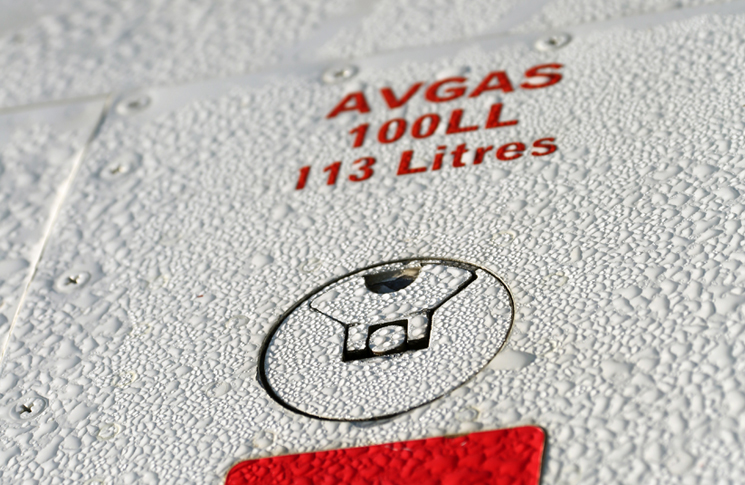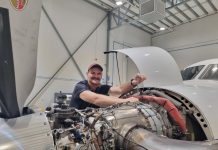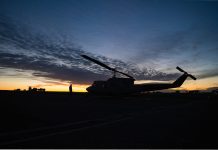To state the obvious: water in fuel is A. Bad. Thing. Whether avgas or jet A1, fuel and water just don’t mix. And water makes engines stop.
Water in fuel takes two forms, dissolved and free. All aviation fuels contain some amount of dissolved water, in the same way that air contains moisture. For engines, dissolved water is not a problem—they tolerate it in the same way we are able to still breathe humid air. Free water is another matter. The amount of free water an aviation piston engine will tolerate before quitting is very small. It’s reckoned to be 30 parts per million—only three millilitres for every 100 litres.
That’s why one of the key rituals of general aviation is tapping the drain points on an aircraft’s tanks before the first flight of the day—and after refuelling. But how does the water get there, and what if the drain points are not where the water collects?
Cleared for take-off: open the throttle, lots of noise, full of confidence and the anticipation of flying, rush up the runway, rotate, launch into the blue, climbing…
It’s at about this point in the flight you may find the acceleration and nose-high attitude has made the undrained water rush to the exits—the main fuel pickup in the tank—and has hosed the fire out in the engine. Another victim of the constant three-pronged attack on the fuel system: fuel caps, tanks and drains.
Caps—attack from above
Water can enter an aircraft’s fuel system through:
- degraded fuel cap seals while sitting in the rain
- being sucked up from the drum and pumped into the aircraft tank with the fuel
- condensation of airborne moisture inside the tank.
Condensation is the reason why it’s better to fill the tanks with fuel if the aircraft is going to sit for a while. More fuel means less air, which in turn means less condensation.
As many general aviation aircraft age fuel cap degradation has the potential to become a greater problem. It has already caused fatalities. On 22 October 2005 a Piper PA-38 Tomahawk on a training flight had a partial power loss shortly after take-off from Biggin Hill, in southern England.
Witnesses spoke of a popping sound and intermittent engine running in the last seconds before the Tomahawk stalled, killing the flight instructor and his student. The cause of the stoppages was found to be a worn fuel filler cap that had allowed water to seep into the fuel tank, causing contamination of the fuel. Significantly, but far from unusual for England, it had rained heavily the night before the flight.
From cloudy Britain to sunny Antigua, where the sands are bright and the rain comes down in buckets—death in paradise. Two almost identical BN2A Britten Norman Islander crashes years apart killed another 12 people due to leaking fuel caps. The ill-fitting fuel caps let water into the fuel tank, which was part of the problem—the other parts were not detecting the water in the fuel tank—and not installing the BN2A modified fuel pick-up. This would have kept the main fuel tank inlets to the engines above the surge tide of undrained water at the back of the fuel sump during the climb.
Fuel caps typically use locking tabs or little lever-type latches of one kind or another to lock the cap and seal the tank. The UK Air Accidents Investigation Branch found the Biggin Hill Tomahawk cap had badly worn lugs and poor seals. Flush cap failure modes include internal and external seal failure, or adverse wear on the latch cam or bearing plates. Ever fiddled with a fuel cap latch just after re-fuelling, trying to get the little latch to sit flat? It’s hello water—goodbye fuel time.
As aircraft components, fuel caps must be maintained in accordance with approved data. However, often there is little such data. Some aircraft manufacturers may list part numbers for the O-ring seals on the filler cap, but may not provide any approved data for repairing and adjusting the cap.
Cessna has developed detailed guidelines for inspection and maintenance of flush-mounted fuel caps and CASA has mandated service information letters SE80-59 and SE82-34, for Cessna 100 and 200 series airworthiness directives (AD). Here’s a test. If you own one of the aeroplanes affected by the AD, next time you are in for maintenance, ask your LAME where the airspeed indicator and beverage tubing used to test the cap seals are. You might get an interesting reply. Or a blank look.
Tanks—a crushing attack
Loose fuel caps can play another dirty trick—siphoning fuel out of wing tanks during flight. This brings us to the next prong in the attack, the fuel tanks. The loose cap exposes the fuel to the low-pressure area over the wing; the fuel then obeys the laws of physics and finds its way out.
If the tank is a rubber fuel cell it will collapse upwards from the bottom, because the top of the rubber fuel cell is secured more firmly to the top wing-tank cavity. This can have at least three effects, all of them bad:
- The bottom of the tank keeps rising. Fuel is thus kept at or near the top of the tank near the cap hole, so that siphoning continues until most or all of the fuel is lost overboard.
- The float of the fuel tank quantity gauge can come into contact with and be supported, or even raised, by the rising of the tank liner bottom. As a result, the cockpit fuel quantity indicator may continue to show full or nearly full, despite the loss of fuel.
- The tank becomes distorted and wrinkled. The tank may not re-shape itself and volume is reduced for the next fill. The valleys now hold lakes and rivers that cannot be drained, until the aircraft is climbing.
You can get the same disastrous crushing effect by using a non-vented fuel cap where a vented cap should be. A blocked vent system can cause a solid fuel tank to be crushed by differential pressure created by engine fuel pumps drawing fuel and atmospheric pressure. (See ‘Honey They Shrunk the Fuel Tanks’. Flight Safety Australia September–October 2001.)
Drains—attack from below
You may find it hard to believe that not all fuel drains are located in the best spot to drain the water. Your aircraft’s tank might be a no-drainer. Wrinkled bottoms and ‘best-guess’ drain locations result in water swilling around in the bottom of the tank, waiting for any opportunity to escape via the main fuel delivery line to the engine. Lowering the tail and wing rocking work to coach water to the drain point on some aircraft types, but on others these are considered to be pretty much futile efforts. Additional fuel drain points are the way to go. Check manufacturer’s service bulletin and supplemental type certificate (STC) options.
Your last line of defence in the battle to keep water out of the fuel is the main filter bowl, the gascolator. Undrainable water from the tank collects in the main gascolator. It may collect little by little, or it may be filled suddenly by rain water getting in through a failed cap in a torrential downpour, or by contaminated fuel. When the fuel bowl is full it passes the water to the engine. This is when your problems begin. Carburetted engines do have capacity to hold water in the bowl, but not very much. A quick-drain in the filter bowl or gascolator is a very good idea.
Further information
CASA AWB 28-008 issue one addressed the Tomahawk crash. Issue 2, expands on its advice. (PDF 23.6KB)






Comments are closed.